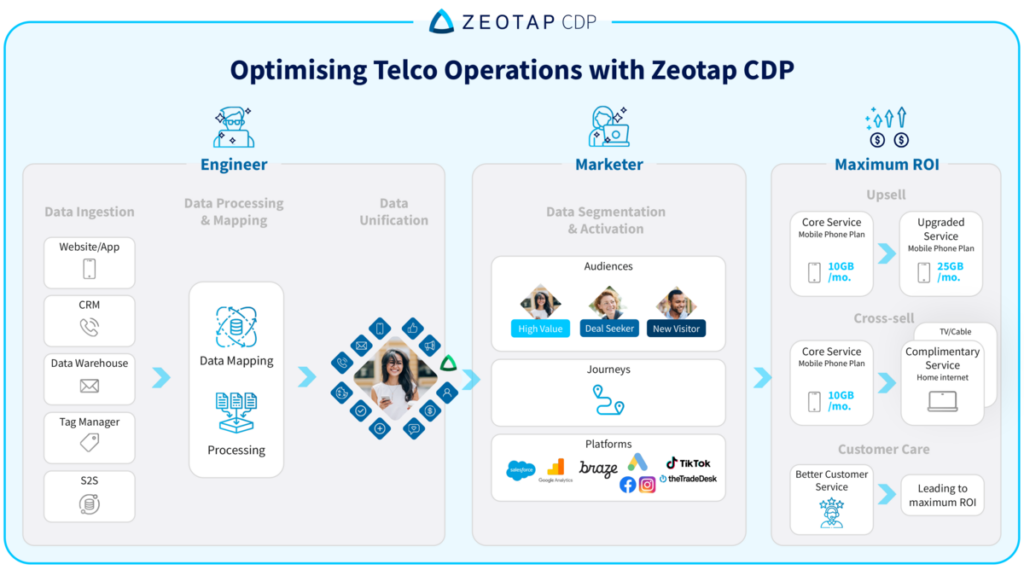Partner Content
In today’s hyper-connected world, Telco companies face unprecedented challenges in managing vast amounts of customer data while striving to deliver seamless experiences across various touchpoints. As Telcos navigate this complex landscape, choosing the right Customer Data Platform (CDP) becomes crucial for unlocking their true potential.
Simply selecting a top-ranked vendor or renowned brand doesn’t guarantee the success of a CDP solution. The reality is far more complex. The key to selecting the right CDP for your company involves a deep dive into the following key areas:
- Data Collection and Integration
- Stitching Capabilities
- Real-Time Data Processing
- Advanced Analytics and AI Capabilities
- Compliance and Data Security
- Scalability and Flexibility
- Type of Use Cases
- Partner for the implementation
In this post, we will provide some essential tips to consider when selecting a CDP tailored for the Telco sector.
1. Comprehensive Data Integration
Telcos operate in a data-rich environment, with information spread across multiple systems and channels. When choosing a CDP, ensure it offers comprehensive data integration capabilities, allowing you to unify data from various sources such as CRM systems, billing platforms, mobile apps, and more. Look for a solution that can seamlessly ingest, cleanse, and harmonise diverse datasets to create a unified view of your customers.
2. Flexible Data Stitching Capabilities
Data stitching is a form of identity resolution that works across platforms, devices, and browsers to combine various identifiers together in order to associate activity to a single individual and create a 360-degree view of customers and their purchase behaviours or interests.
However, not all CDPs present the same stitching capabilities, and there is a wide range of proficiency amongst CDP vendors regarding which types of identifiers are compatible, the possibility to combine both probabilistic and deterministic identifiers, if offline events can be ingested and processed, the number of identifiers that can be used, and how long does it take for the system to combine identifiers together. Telcos should explore this capability to understand which one is the best fit for their strategy.
3. Real-Time Data Processing
In the fast-paced Telco industry, real-time insights are paramount for delivering personalised experiences and responding swiftly to customer needs. Prioritise CDPs that support real-time data processing, enabling you to capture, analyse, and act upon customer interactions instantaneously. Whether it’s identifying upsell opportunities, resolving service issues, or triggering targeted campaigns, real-time capabilities can make a significant difference in enhancing customer satisfaction and driving business outcomes.
4. Advanced Analytics and AI Capabilities
Harnessing the power of advanced analytics and artificial intelligence (AI) is essential for Telcos looking to gain actionable insights from their data. Seek out CDPs that offer robust analytics and AI capabilities, including predictive modelling, segmentation, propensity scoring, and churn prediction. These features empower Telcos to uncover hidden patterns, forecast customer behaviour, and proactively address customer needs, ultimately driving revenue growth and profitability.
5. Compliance and Data Security
With stringent regulations such as GDPR and CCPA governing data privacy and security, compliance is non-negotiable for Telcos. Prioritise CDPs that adhere to industry standards and regulations, ensuring compliance with data protection laws and safeguarding customer information against unauthorised access or misuse. Look for certifications such as SOC 2, ISO 27001, or GDPR compliance to ensure the highest levels of security and compliance within your organisation.
6. Scalability and Flexibility
As Telcos scale their operations and expand their customer base, scalability and flexibility become critical considerations when selecting a CDP. Choose a solution that can grow with your business needs, offering scalability to handle increasing data volumes and supporting seamless integration with new technologies and systems. Additionally, opt for a flexible CDP that allows customisation and adaptation to unique business requirements, empowering Telcos to stay agile and responsive in a dynamic market environment.

7. Type of Use Cases
It is important to start the selection of a CDP by evaluating what kind of use cases need to be addressed. If they are purely marketing of hybrid. Furthermore use cases should be derived deductively based on the defined targets, with an ideal balance between initial cost and time to implement and their expected outcomes.
8. Partner for the Implementation
Implementing a CDP is time-consuming and it can be expensive. It needs to be done in the right way. The CDP’s success also depends a lot on the partner who is implementing it and their knowledge of data, digital, marketing, and tech. Choosing the right CDP software and the wrong implementation partner can lead to a failed project. This is why it is necessary to evaluate if a CDP vendor can help to overlook the general strategy, by defining commercial targets, shortlisting use cases, and evolving the operating model and incentive schemes, or if you need a consultant to oversee these operations. Only with this kind of approach, a CDP implementation can drive strong positive ROI for organisations.
Conclusion
In conclusion, choosing the right CDP is a strategic decision that can significantly impact the success of Telco companies. By prioritising comprehensive data integration, real-time processing, advanced analytics, compliance, scalability, and flexibility, Telcos can unlock the full potential of their customer data and drive superior business outcomes in today’s competitive landscape.
